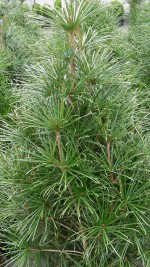 This evergreen conifer native of Japan is the only member of its genus and family making it a fossil tree. With no close relatives, Japanese umbrella pine is very distinct looking and difficult to find but makes a unique and attractive specimen tree. The common name, umbrella pine, refers to the way the needles grow in whorls on the shoots like the ribs of an umbrella, not the tree’s silhouette. The 20-30 needles in the terminal whorls are 2-5” long, flattened, dark green and glossy. Smaller scale-like needles cover the shoot below the terminal whorls. The trees are compact when young becoming more open and loose as they mature and are often multi-stemmed with a conical or columnar shape. The exfoliating orange bark is attractive but usually hidden by the foliage. Male and female cones are produced on the same tree and seed bearing cones are 2-4” long, and chunky. Although the height in the wild can be 100’ these long lived trees are very slow growing and rarely exceed 40’ making them a good choice for a conifer or rock garden. Avoid windy sites and protect from ice and heavy snowfall. Some fine cultivars are available including white and yellow variegated ones.
This evergreen conifer native of Japan is the only member of its genus and family making it a fossil tree. With no close relatives, Japanese umbrella pine is very distinct looking and difficult to find but makes a unique and attractive specimen tree. The common name, umbrella pine, refers to the way the needles grow in whorls on the shoots like the ribs of an umbrella, not the tree’s silhouette. The 20-30 needles in the terminal whorls are 2-5” long, flattened, dark green and glossy. Smaller scale-like needles cover the shoot below the terminal whorls. The trees are compact when young becoming more open and loose as they mature and are often multi-stemmed with a conical or columnar shape. The exfoliating orange bark is attractive but usually hidden by the foliage. Male and female cones are produced on the same tree and seed bearing cones are 2-4” long, and chunky. Although the height in the wild can be 100’ these long lived trees are very slow growing and rarely exceed 40’ making them a good choice for a conifer or rock garden. Avoid windy sites and protect from ice and heavy snowfall. Some fine cultivars are available including white and yellow variegated ones.
Type: Evergreen tree
Outstanding Features: Terminal whorls of needles
Form: Conical to columnar
Growth Rate: Slow
Bloom: Male and female cones on the same tree
Size: 25-40’ H x 15-20’ W
Light: Full sun; appreciates some afternoon shade in hot climates
Soil: Organically rich, moist, acidic
Hardiness: Zones 5-8
Care: Low maintenance
Pests and Diseases: None of significance
Propagation: Seed; semi-ripe cuttings in summer
Outstanding Selection: ‘Wintergreen’ ( slender conical form with good color throughout the year).
